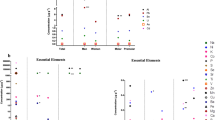Abstract
The study determines the concentration of Ba in mineralized tissues of deciduous teeth, permanent impacted teeth, and facial bones. The study covers the population of children and adults (aged 6–78) living in an industrial area of Poland. Teeth were analyzed in whole, with no division into dentine and enamel. Facial bones and teeth were subjected to the following preparation: washing, drying, grinding in a porcelain mortar, sample weighing (about 0.2 g), and microwave mineralization with spectrally pure nitric acid. The aim of the study was to determinate the concentration of Ba in deciduous teeth, impacted permanent teeth, and facial bones. The concentration of barium in samples was determined over the ICP OES method. The Ba concentration in the tested bone tissues amounted to 2.2-15.5 μg/g (6.6 μg/g ± 3.9). The highest concentration of Ba was present in deciduous teeth (10.5 μg/g), followed by facial bones (5.2 μg/g), and impacted teeth (4.3 μg/g) (ANOVA Kruskal-Wallis rank test, p = 0.0002). In bone tissue and impacted teeth, Ba concentration increased with age. In deciduous teeth, the level of Ba decreased with children’s age.


Similar content being viewed by others
References
Polish Geological Institute, National Research Institute, http://www.pgi.gov.pl/attachments/article/434/war1_50zal.jpg. Accessed April 2014
Rosborg I, Nihlgard B, Gerhardsson L (2003) Ambio 32:440–446
Oskarsoon A, Reeves AL (2007) Barium. In: Nordberg GF et al (eds)Handbook on the Toxicology of metals. Elsevier, Amsterdam, pp 407–414
WHO (1990) Environ Health Criteria 107
Krachler M, Rossipal E, Micetic-Truk D (1999) Concentrations of trace elements in sera of newborns, young infants, and adults. Biol Trace Elem Res 68:121–135
Austin C, Smith TM, Bradman A, Hinde K, Joannes-Boyau R, Bishop D, Hare DJ, Doble P, Eskenazi B, Arora M (2013) Barium distributions in teeth reveal early-life dietary transition in primates. Nature 13(498):216–220
Tomczyk J, Szostek K, Komarnitki, Mańkowska-Pliszka H, Zalewska M (2013) Dental caries and chemical analyses in reconstruction of diet, health and hygienic behaviour in the Middle Euphrates (Syria). Arch Oral Biol 58:740–751
Rosenthal HL (1981) Content of stable strontium in man and animal biota. In: Skloryna SC (ed) Handbook of stable Strontium. Plenum, New York
Szostek K, Gołąb H, Pudło A (2009) The use of strontium and barium analyses for the reconstruction of the diet of the early medieval coastal population of Gdańsk (Poland): a preliminary study. HOMO-J Comp Hum Biol 60:359–372
Arora M, Kennedy JB, Elhlou S, Pearson NJ, Walker DM, Bayl P, Chan SWY (2006) Spatial distribution of lead in human primary teeth as a biomarker of pre- and neonatal lead exposure. Sci Total Environ 371:55–62
Arora M, Hare D, Austin C, Smith DR, Doble P (2011) Spatial distribution of manganese in enamel and coronal dentine of human primary teeth. Sci Total Environ 409:1315–1319
De Souza-Guerra C, Barroso RC, de Almeida AP, Pexioto AIT, Moreira S, de Sousa FB, Gerlach RF (2014) Anatomical variations in primary teeth microelements with known differences in lead content by micro-synchrotron radiation X-Ray fluorescence (μ-SRXRF)—a preliminary study. J Trace Elem Med Biol 28:186–193
Lis J, Pasieczna A (1995) Geochemical atlas of Upper Silesia. Państwowy Instytut Wydawniczy, Warszawa
Kwapuliński J, Malara P, Fischer A, Wiechuła D (2004) The teeth as the bioindicators of environmental exposure to chromium. Pol J Env Stud 13:43–48
Fischer A, Wiechuła D, Kwapuliński J (2004) The lead content of teeth in inhabitants of the Silesian region. Czas Stomatol 57(3):177–182
Manea-Krichten M, Patterson C, Miller G, Settle D, Erel Y (1991) Comparative increases of lead and barium with age in human tooth enamel, rib and ulna. Sci Total Environ 107:179–203
Yoshinaga J, Suzuki T, Morita M, Hayakawa M (1995) Trace elements in ribs of elderly people and elemental variation in the presence of chronic diseases. Sci Total Environ 162:239–252
Liu HY, Chao JH, Chuang CY, Chiu HL, Yang CW, Sun YC (2013) Study of P, Ca, Sr, Ba and Pb levels in enamel and dentine of human third molars for environmental and archaeological research. Adv Archeol 3(2):71–77
Inspection of Environmental Protection (2010) Wyniki pięcioletniej ocent jakości powietrza w strefach w Polsce. IEP, Warszawa
Brown CJ, Chenery SR, Smith B, Tomkins A, Roberts GJ, Sserunjogi L, Thompson M (2002) A sampling and analytical methodology for dental trace element analysis. Analyst 127(2):319–323
Fischer A, Wiechuła D, Postek-Stefańska L, Kwapuliński J (2009) Concentrations of metals in maxilla and mandible deciduous and permanent teeth. Biol Trace Elem Res 132:19–26
Szpringer-Nodzak M, Wochna-Sobańska M (2005) Stomatologia wieku rozwojowego. PZWL, Warszawa
Fischer A, Wiechuła D, Przybyła-Misztela C (2013) Changes of concentrations of elements in deciduous teeth with age. Biol Trace Elem Res 154:427–432
He B, Huang S, Zhang C, Jing J, Hao Y, Xiao L, Zhou X (2011) Mineral densities and elemental content in different layers of healthy human enamel with varying teeth age. Arch Oral Biol 56:997–1004
Acknowledgments
This work was financed by the Medical University of Silesia in Katowice (contract no. KNW-1-124/K/4/0).
Author information
Authors and Affiliations
Corresponding author
Rights and permissions
About this article
Cite this article
Fischer, A., Malara, P. & Wiechuła, D. The Study of Barium Concentration in Deciduous Teeth, Impacted Teeth, and Facial Bones of Polish Residents. Biol Trace Elem Res 161, 32–37 (2014). https://doi.org/10.1007/s12011-014-0061-1
Received:
Accepted:
Published:
Issue Date:
DOI: https://doi.org/10.1007/s12011-014-0061-1




